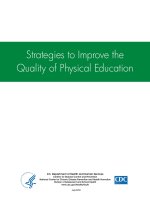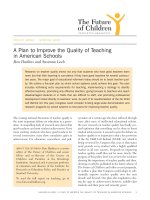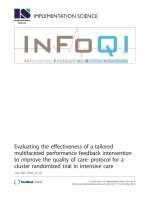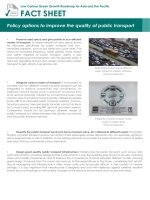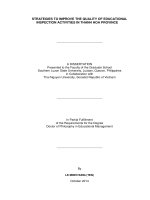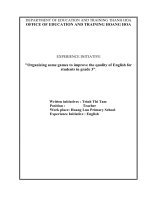Strategies to Improve the Quality of Physical Education pot
Bạn đang xem bản rút gọn của tài liệu. Xem và tải ngay bản đầy đủ của tài liệu tại đây (597.93 KB, 4 trang )
Strategies to Improve the
Quality of Physical Education
U.S. Department of Health and Human Services
Centers for Disease Control and Prevention
National Center for Chronic Disease Prevention and Health Promotion
Division of Adolescent and School Health
www.cdc.gov/HealthyYouth
July 2010
Strategies to Improve the Quality of Physical Education
Establishing and implementing high-quality physical
education (PE) programs can provide students with the
appropriate knowledge, skills, behaviors, and condence
to be physically active for life. High-quality PE is the
cornerstone of a school’s physical activity program.
Benets of Physical Activity
• The U.S. Department of Health and Human Services
(HHS) recommends that young people participate
in at least 60 minutes of moderate to vigorous
physical activity (MVPA) daily to obtain multiple
health benets, such as decreased likelihood of
developing heart disease, type 2 diabetes, and
obesity. For overweight and obese youth, physical
activity can reduce body fatness.
1
• Additionally, participation in physical activity is
associated with academic benets such as improved
concentration,
2-3
memory,
4
and classroom behavior.
5-7
Insufcient Physical Activity
Levels Among Youth
• In 2009, less than 20% of adolescents participated
in physical activity for at least 60 minutes daily.
8
• About one in four adolescents does not engage in 60
minutes of physical activity on any days of the week.
8
The Current State of Physical
Education
Physical education (PE) is an effective strategy to
increase physical activity among young people.
HHS recommends that students engage in MVPA for
at least 50% of the time they spend in PE class—one
of the most critical outcome measures in determining
the quality of a PE program.
• Nine studies have documented that, in typical PE
classes, students engage in MVPA less than 50% of
class time.
9-17
• PE teachers use too much of their class time
for activities related to administrative and
management tasks (e.g., taking attendance, making
announcements). Student MVPA rates are lowest during
these types of activities. One study found that 15-26%
of PE class time was spent on management tasks.
18
Education
Improving the Quality of Physical
Studies have shown that programs designed to improve
the quality of PE can increase the amount of time that
students are engaged in MVPA to more than 50% of PE
class time.
18-23
For example:
• The Child and Adolescent Trial for Cardiovascular
Health (CATCH) intervention, implemented in 96
elementary schools in four U.S. cities, increased
average percentage of time spent in MVPA during
PE classes from 37.4% at baseline to 51.9% at
follow-up.
19
• A middle school PE intervention, implemented in six
middle schools in four U.S. cities, led to an average
of 58.7% of class time being spent in MVPA.
18
11
2
Strategies to Improve the Quality of Physical Education
Key Strategies for Improving the
Quality of Physical Education
Programs designed to improve the quality of PE have
used two key strategies to increase student time in MVPA
during PE class:
1) Implement a well-designed curriculum.
In PE, as in any other academic subject, the curriculum
shapes instruction by mapping out for teachers what
students should be taught and how their acquisition of
knowledge and skills should be assessed. A 2006 CDC
survey found that nearly half of the nation’s schools do
not even have a PE curriculum.
24
A high-quality, well-
designed PE curriculum
• Is based on national, state, or local PE standards that
describe what students should know and be able to
do as a result of a high-quality PE program.
• Is designed to maximize physical activity during
lessons and keep students moderately to vigorously
active for at least 50% of class time.
• Includes student assessment protocols to determine
if students are getting enough MVPA during PE and
achieving learning objectives and standards.
Programs that increased students’ time engaged in
MVPA modied the PE curricula by
• Replacing games or activities that tended to
provide lower levels of physical activity (e.g.,
softball) with activities that were inherently more
active (e.g., aerobic dance, aerobic games, jump
rope).
18-19,23,25
• Adding tness and circuit training stations to lesson
plans.
18-19,22-23,25
• Providing teachers with a menu of MVPA activities to
help build more active lessons.
18,25
PE standards. Results from PECAT can help schools
enhance an existing curriculum, develop their own
curriculum, or select a published curriculum for the
delivery of high-quality PE in schools. The tool is
available online at www.cdc.gov/healthyyouth/pecat.
CDC’s Physical Education Curriculum Analysis Tool
(PECAT) helps school districts conduct a comprehensive
analysis of written PE curricula, based on evidence-
based characteristics of effectiveness and the national
2) Provide teachers with appropriate training and
supervision.
Improving the qualications and skills of PE teachers
requires appropriate training and supervision. Well-
designed professional development can help PE teachers
increase the amount of time students spend in MVPA
and decrease the amount of time spent on administrative
and classroom management tasks.
18-19,25
Programs that have increased students’ time engaged in
MVPA provided teachers with appropriate training and
supervision by
• Training PE specialists and classroom teachers
on ways to minimize time spent on classroom
management, transitions, and administrative tasks.
25
• Providing on-site consultation and regular feedback
to teachers on their instructional strategies.
20-21
• Training master PE teachers to teach and mentor
other PE teachers about strategies for increasing
MVPA during PE class.
18
To increase the time that students spend engaged in
MVPA during PE classes, all PE teachers should receive
• Targeted training on methods to increase the amount
of class time students are engaged in MVPA. In
2006 less than half of the nation’s PE classes
had a teacher who had received this type of staff
development.
24
• Specic training about how to implement the PE
curriculum they will be using.
• Annual professional development opportunities to
enhance their instructional skills and techniques.
• Feedback through supervision and mentoring from
master PE teachers.
3
Strategies to Improve the Quality of Physical Education
Reference List
1. US Department of Health and Human Services. 2008 Physical Activity Guidelines for Americans. Washington, DC: US Dept of Health and Human Services; 2008.
2. Budde H, Voelcker-Rehage C, Pietrasyk-Kendziorra S, Ribeiro P, Tidow G. Acute coordinative exercise improves attentional performance in adolescents. Neurosci Lett 2008;441(2):219-23.
3. Caterino MC, Polak ED. Effects of two types of activity on the performance of second-, third-, and fourth-grade students on a test of concentration. Percept Mot Skills 1999;89(1):245-8.
4. Della Valle J, Dunn R, Geisert G, Sinatra R, Zenhausern R. The effects of matching and mismatching students’ mobility preferences on recognition and memory tasks. J Educ Res.
1986;79(5):267-72.
5. Dwyer T, Blizzard L, Dean K. Physical activity and academic performance in children. Nutr Re. 1996;54(4):S27-31.
6. Jarrett OS, Maxwell DM, Dickerson C, Hoge P, Davies G, Yetley A. Impact of recess on classroom behavior: group effects and individual differences. J Educ Res 1998;92(2):121-6.
7. Barros RM, Silver EJ, Stein RE. School recess and group classroom behavior Pediatrics 2009;123(2):431-6.
8. Centers for Disease Control and Prevention. Youth risk behavior surveillance—United States, 2009. MMWR 2010;59(SS-5):1-142.
9. Simons-Morton BG, Taylor WC, Snider SA, Huang IW, Fulton JE. Observed levels of elementary and middle school children’s physical activity during physical education classes. Prev Med
1994:23(4):437-41.
10. Scruggs PW, Beveridge SK, Eisenman PA, Watson DL, Schultz BB, Ransdell LB. Quantifying physical activity via pedometry in elementary physical education. Med. Sci. Sports Exerc
2003;35(6):1065-71.
11. Nader PL, National Institute of Child Health and Human Development Study of Early Child Care and Youth Development Network. Frequency and intensity of activity of third-grade children
in physical education. Arch Pediatr Adolesc Med 2003;157(2):185-90.
12. Levin S, McKenzie TL, Hussey JR, Kelder SH, Lytle LA. Variability of physical activity during physical education lessons across elementary school grades. Meas Phys Educ Exerc Sci
2001;5(4):207-18.
13. Coe DP, Pivarnik JM, Womack CJ, Reeves MJ, Malina RM. Effect of physical education and activity levels on academic achievement in children. Med Sci Sports Exerc 2006;38(8):1515-9.
14. McKenzie TL, Marshall SJ, Sallis JF, Conway TL. Student activity levels, lesson context, and teacher behavior during middle school physical education. Res Q Exercise Sport
2000;71(3):249-59.
15. McKenzie TL, Catellier DJ, Conway T, Lytle LA, Grieser M, Webber LA, et al. Girls’ activity levels and lesson contexts in middle school PE: TAAG baseline. Med Sci Sports Exerc
2006;38(7):1229-35.
16. Van Beurden E, Barnett LM, Zask A, Dietrich UC, Brooks LO, Beard J. Can we skill and activate children through primary school physical education lessons? “Move it Groove it”—a
collaborative health promotion intervention. Prev Med 2003;36(4):493-501.
17. Fairclough S, Stratton G. “Physical education makes you fit and healthy.” Physical education’s contribution to young people’s physical activity levels. Health Educ Res 2005;20(1):14-23.
18. Jago R, McMurray RG, Bassin S, Pyle L, Bruecker S, Jakicic JM, et al. Modifying middle school physical education: Piloting strategies to increase physical activity. Pediatr Exercise Sci
2009;21(2):171-85.
19. McKenzie TL, Nader PR, Strikmiller PK, Yang M, Stone EJ, Perry CL, et al. School physical education: Effect of the Child and Adolescent Trial for Cardiovascular Health. Prev Med
1996;25(4):423-31.
20. McKenzie TL, Li D, Derby CA, Webber LS, Luepker RV, Cribb P. Maintenance of effects of the CATCH physical education program: Results from the CATCH-ON study. Health Educ Behav
2003;30(4):447-62 .
21. McKenzie TL, Sallis JF, Prochaska JJ, Conway TL, Marshall SJ, Rosengard P. Evaluation of a two-year middle-school physical education intervention: M-SPAN. Med Sci Sports Exerc
2004;36(8):1382-8.
22. Donnelly JE, Jacobsen DJ, Whatley JE, Hill JO, Swift LL, Cherrington A, et al. Nutrition and physical activity program to attenuate obesity and promote physical and metabolic fitness in
elementary school children. Obes Res 1996;4(3):229-43.
23. Simons-Morton BG, Parcel GS, Baranowski T, Forthofer R, O’Hara NM. Promoting physical activity and a healthful diet among children: results of a school-based intervention study. Am J
Pub Health 1991;81(8):986-91.
24. Lee SM, Burgeson CR, Fulton JE, Spain CG. Physical education and physical activity: Results from the School Health Policies and Programs Study 2006. J Sch Health 2007;77(8):435-63.
25. Sallis JF, McKenzie TL, Alcaraz JE, Kolody B, Faucette N, Hovell MF. The effects of a 2 year physical education program (SPARK) on physical activity and fitness in elementary school
students. Sports, Play and Active Recreation for Kids. Am J Public Health 1997;87(8):1328-34.

